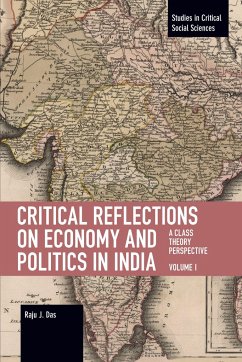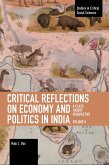- Broschiertes Buch
- Merkliste
- Auf die Merkliste
- Bewerten Bewerten
- Teilen
- Produkt teilen
- Produkterinnerung
- Produkterinnerung
A magisterial class based analysis of the economic situation in contemporary India
Andere Kunden interessierten sich auch für
![Critical Reflections on Economy and Politics in India. Volume 2 Critical Reflections on Economy and Politics in India. Volume 2]() Raju J DasCritical Reflections on Economy and Politics in India. Volume 235,99 €
Raju J DasCritical Reflections on Economy and Politics in India. Volume 235,99 €![The English Utilitarians and India. -- The English Utilitarians and India. --]() Eric StokesThe English Utilitarians and India. --27,99 €
Eric StokesThe English Utilitarians and India. --27,99 €![Critical Reflections on Australian Public Policy: Selected Essays Critical Reflections on Australian Public Policy: Selected Essays]() Critical Reflections on Australian Public Policy: Selected Essays29,99 €
Critical Reflections on Australian Public Policy: Selected Essays29,99 €![Azadi Azadi]() Arundhati RoyAzadi17,99 €
Arundhati RoyAzadi17,99 €![Beyond Dogmatism Beyond Dogmatism]() Andrea BorghiniBeyond Dogmatism30,99 €
Andrea BorghiniBeyond Dogmatism30,99 €![Not All Politics Is Local: Reflections of a Former County Chairman Not All Politics Is Local: Reflections of a Former County Chairman]() William D. Angel JrNot All Politics Is Local: Reflections of a Former County Chairman26,99 €
William D. Angel JrNot All Politics Is Local: Reflections of a Former County Chairman26,99 €![The Vanishing Congress: Reflections on Politics in Washington The Vanishing Congress: Reflections on Politics in Washington]() Jeff BergnerThe Vanishing Congress: Reflections on Politics in Washington20,99 €
Jeff BergnerThe Vanishing Congress: Reflections on Politics in Washington20,99 €-
-
-
A magisterial class based analysis of the economic situation in contemporary India
Hinweis: Dieser Artikel kann nur an eine deutsche Lieferadresse ausgeliefert werden.
Hinweis: Dieser Artikel kann nur an eine deutsche Lieferadresse ausgeliefert werden.
Produktdetails
- Produktdetails
- Verlag: Haymarket Books
- Seitenzahl: 350
- Erscheinungstermin: 31. August 2021
- Englisch
- Abmessung: 224mm x 150mm x 22mm
- Gewicht: 499g
- ISBN-13: 9781642593600
- ISBN-10: 1642593605
- Artikelnr.: 62163663
- Herstellerkennzeichnung
- Libri GmbH
- Europaallee 1
- 36244 Bad Hersfeld
- gpsr@libri.de
- Verlag: Haymarket Books
- Seitenzahl: 350
- Erscheinungstermin: 31. August 2021
- Englisch
- Abmessung: 224mm x 150mm x 22mm
- Gewicht: 499g
- ISBN-13: 9781642593600
- ISBN-10: 1642593605
- Artikelnr.: 62163663
- Herstellerkennzeichnung
- Libri GmbH
- Europaallee 1
- 36244 Bad Hersfeld
- gpsr@libri.de
Raju J. Das holds a Ph.D. from The Ohio State University, Columbus, and is currently a Professor at York University, Toronto. He is the author of Marxist Class Theory for a Sceptical World.
Acknowledgements
List of Illustrations
Preface to Paperback Editions
1 Introduction
1 Why Class?
2 Why Not Class – Why Not a Class-Based Analytical Framework?
3 Components of a Class-Based Framework for Understanding Contemporary
India
4 The Chapter Outline
2 Class in India
1 Existing Criticisms against Class Analysis of India
2 Existing Approaches to Class in India
3 A Critique of Existing Approaches to Class in India
4 Constructing a Class-Based Framework
5 Conclusion
3 The Capitalist Character of Class Society in Post-colonial India:
Moving Beyond the Mode of Production Debate
1 The Development of Capitalist Relations, and the Barriers to This: A
Brief Discussion on the Indian Mode of Production Debate
2 A Critique of Some Influential Ideas in the Indian Mode of Production
Debate
3 Examining India’s Capitalist Character on the Basis of Marx’s
Distinction between Formal and Real Subsumptions of Labor
4 Class Struggle and the (Slow and Uneven) Transition to Real Subsumption
of Labor
5 Class Struggle and the ‘Blocked’ Transition to Real Subsumption of Labor
6 Possibilities of, and Limits to, Real Subsumption of Labor
7 Jairus Banaji’s (and Others’) Mistaken Subsumption of Labor Perspective
8 Conclusion
4 Neoliberal Capitalism with Indian Characteristics
1 Neoliberalism: Its General Traits
2 Neoliberalism in India: The Context
3 Neoliberalism with Indian Characteristics: Eight Theses
4 Concluding Comments: What Is to Be Done?
5 Capitalism and Technological Change: Reflections on the
Technology-Poverty Relation
1 The Literature on the Green Revolution and Poverty: The Thesis and the
Anti-thesis
2 The Literature on the Green Revolution and Poverty: A Critique of
Neo-Malthusianism
3 Technology, Population and Poverty: A Contingent Relation
4 The Green Revolution and Poverty in India: An Empirical Analysis
5 Conclusion
6 Low-Wage Neoliberal Capitalism, Social-Cultural Difference, and
Nature-Dependent Production
1 Shrimp Aquaculture and the Missing Laborer
2 A Labor-Based Approach to Nature-Dependent Commodity Production
3 The Local, National and the Global Contexts
4 Working for Less and in Poor Conditions: ‘Capital’ Negated
5 Making Sense of Low-Wage Capitalism: From the General to the Locally
Specific
6 Conclusion
7 Class Relations, Class Struggle, and the State in India
1 Existing Views on the Indian State: A Critical Review
2 The Indian State and Its Class Base
3 A Coalition/Alliance of Proprietary Classes
4 The Indian State, Lower Classes, and Lower-Class Struggle
5 State Form, State Policy, and Class Struggle
6 The Indian State and the Class Contradictions of Economic Development
7 Conclusion
Bibliography
Index
List of Illustrations
Preface to Paperback Editions
1 Introduction
1 Why Class?
2 Why Not Class – Why Not a Class-Based Analytical Framework?
3 Components of a Class-Based Framework for Understanding Contemporary
India
4 The Chapter Outline
2 Class in India
1 Existing Criticisms against Class Analysis of India
2 Existing Approaches to Class in India
3 A Critique of Existing Approaches to Class in India
4 Constructing a Class-Based Framework
5 Conclusion
3 The Capitalist Character of Class Society in Post-colonial India:
Moving Beyond the Mode of Production Debate
1 The Development of Capitalist Relations, and the Barriers to This: A
Brief Discussion on the Indian Mode of Production Debate
2 A Critique of Some Influential Ideas in the Indian Mode of Production
Debate
3 Examining India’s Capitalist Character on the Basis of Marx’s
Distinction between Formal and Real Subsumptions of Labor
4 Class Struggle and the (Slow and Uneven) Transition to Real Subsumption
of Labor
5 Class Struggle and the ‘Blocked’ Transition to Real Subsumption of Labor
6 Possibilities of, and Limits to, Real Subsumption of Labor
7 Jairus Banaji’s (and Others’) Mistaken Subsumption of Labor Perspective
8 Conclusion
4 Neoliberal Capitalism with Indian Characteristics
1 Neoliberalism: Its General Traits
2 Neoliberalism in India: The Context
3 Neoliberalism with Indian Characteristics: Eight Theses
4 Concluding Comments: What Is to Be Done?
5 Capitalism and Technological Change: Reflections on the
Technology-Poverty Relation
1 The Literature on the Green Revolution and Poverty: The Thesis and the
Anti-thesis
2 The Literature on the Green Revolution and Poverty: A Critique of
Neo-Malthusianism
3 Technology, Population and Poverty: A Contingent Relation
4 The Green Revolution and Poverty in India: An Empirical Analysis
5 Conclusion
6 Low-Wage Neoliberal Capitalism, Social-Cultural Difference, and
Nature-Dependent Production
1 Shrimp Aquaculture and the Missing Laborer
2 A Labor-Based Approach to Nature-Dependent Commodity Production
3 The Local, National and the Global Contexts
4 Working for Less and in Poor Conditions: ‘Capital’ Negated
5 Making Sense of Low-Wage Capitalism: From the General to the Locally
Specific
6 Conclusion
7 Class Relations, Class Struggle, and the State in India
1 Existing Views on the Indian State: A Critical Review
2 The Indian State and Its Class Base
3 A Coalition/Alliance of Proprietary Classes
4 The Indian State, Lower Classes, and Lower-Class Struggle
5 State Form, State Policy, and Class Struggle
6 The Indian State and the Class Contradictions of Economic Development
7 Conclusion
Bibliography
Index
Acknowledgements
List of Illustrations
Preface to Paperback Editions
1 Introduction
1 Why Class?
2 Why Not Class – Why Not a Class-Based Analytical Framework?
3 Components of a Class-Based Framework for Understanding Contemporary
India
4 The Chapter Outline
2 Class in India
1 Existing Criticisms against Class Analysis of India
2 Existing Approaches to Class in India
3 A Critique of Existing Approaches to Class in India
4 Constructing a Class-Based Framework
5 Conclusion
3 The Capitalist Character of Class Society in Post-colonial India:
Moving Beyond the Mode of Production Debate
1 The Development of Capitalist Relations, and the Barriers to This: A
Brief Discussion on the Indian Mode of Production Debate
2 A Critique of Some Influential Ideas in the Indian Mode of Production
Debate
3 Examining India’s Capitalist Character on the Basis of Marx’s
Distinction between Formal and Real Subsumptions of Labor
4 Class Struggle and the (Slow and Uneven) Transition to Real Subsumption
of Labor
5 Class Struggle and the ‘Blocked’ Transition to Real Subsumption of Labor
6 Possibilities of, and Limits to, Real Subsumption of Labor
7 Jairus Banaji’s (and Others’) Mistaken Subsumption of Labor Perspective
8 Conclusion
4 Neoliberal Capitalism with Indian Characteristics
1 Neoliberalism: Its General Traits
2 Neoliberalism in India: The Context
3 Neoliberalism with Indian Characteristics: Eight Theses
4 Concluding Comments: What Is to Be Done?
5 Capitalism and Technological Change: Reflections on the
Technology-Poverty Relation
1 The Literature on the Green Revolution and Poverty: The Thesis and the
Anti-thesis
2 The Literature on the Green Revolution and Poverty: A Critique of
Neo-Malthusianism
3 Technology, Population and Poverty: A Contingent Relation
4 The Green Revolution and Poverty in India: An Empirical Analysis
5 Conclusion
6 Low-Wage Neoliberal Capitalism, Social-Cultural Difference, and
Nature-Dependent Production
1 Shrimp Aquaculture and the Missing Laborer
2 A Labor-Based Approach to Nature-Dependent Commodity Production
3 The Local, National and the Global Contexts
4 Working for Less and in Poor Conditions: ‘Capital’ Negated
5 Making Sense of Low-Wage Capitalism: From the General to the Locally
Specific
6 Conclusion
7 Class Relations, Class Struggle, and the State in India
1 Existing Views on the Indian State: A Critical Review
2 The Indian State and Its Class Base
3 A Coalition/Alliance of Proprietary Classes
4 The Indian State, Lower Classes, and Lower-Class Struggle
5 State Form, State Policy, and Class Struggle
6 The Indian State and the Class Contradictions of Economic Development
7 Conclusion
Bibliography
Index
List of Illustrations
Preface to Paperback Editions
1 Introduction
1 Why Class?
2 Why Not Class – Why Not a Class-Based Analytical Framework?
3 Components of a Class-Based Framework for Understanding Contemporary
India
4 The Chapter Outline
2 Class in India
1 Existing Criticisms against Class Analysis of India
2 Existing Approaches to Class in India
3 A Critique of Existing Approaches to Class in India
4 Constructing a Class-Based Framework
5 Conclusion
3 The Capitalist Character of Class Society in Post-colonial India:
Moving Beyond the Mode of Production Debate
1 The Development of Capitalist Relations, and the Barriers to This: A
Brief Discussion on the Indian Mode of Production Debate
2 A Critique of Some Influential Ideas in the Indian Mode of Production
Debate
3 Examining India’s Capitalist Character on the Basis of Marx’s
Distinction between Formal and Real Subsumptions of Labor
4 Class Struggle and the (Slow and Uneven) Transition to Real Subsumption
of Labor
5 Class Struggle and the ‘Blocked’ Transition to Real Subsumption of Labor
6 Possibilities of, and Limits to, Real Subsumption of Labor
7 Jairus Banaji’s (and Others’) Mistaken Subsumption of Labor Perspective
8 Conclusion
4 Neoliberal Capitalism with Indian Characteristics
1 Neoliberalism: Its General Traits
2 Neoliberalism in India: The Context
3 Neoliberalism with Indian Characteristics: Eight Theses
4 Concluding Comments: What Is to Be Done?
5 Capitalism and Technological Change: Reflections on the
Technology-Poverty Relation
1 The Literature on the Green Revolution and Poverty: The Thesis and the
Anti-thesis
2 The Literature on the Green Revolution and Poverty: A Critique of
Neo-Malthusianism
3 Technology, Population and Poverty: A Contingent Relation
4 The Green Revolution and Poverty in India: An Empirical Analysis
5 Conclusion
6 Low-Wage Neoliberal Capitalism, Social-Cultural Difference, and
Nature-Dependent Production
1 Shrimp Aquaculture and the Missing Laborer
2 A Labor-Based Approach to Nature-Dependent Commodity Production
3 The Local, National and the Global Contexts
4 Working for Less and in Poor Conditions: ‘Capital’ Negated
5 Making Sense of Low-Wage Capitalism: From the General to the Locally
Specific
6 Conclusion
7 Class Relations, Class Struggle, and the State in India
1 Existing Views on the Indian State: A Critical Review
2 The Indian State and Its Class Base
3 A Coalition/Alliance of Proprietary Classes
4 The Indian State, Lower Classes, and Lower-Class Struggle
5 State Form, State Policy, and Class Struggle
6 The Indian State and the Class Contradictions of Economic Development
7 Conclusion
Bibliography
Index








